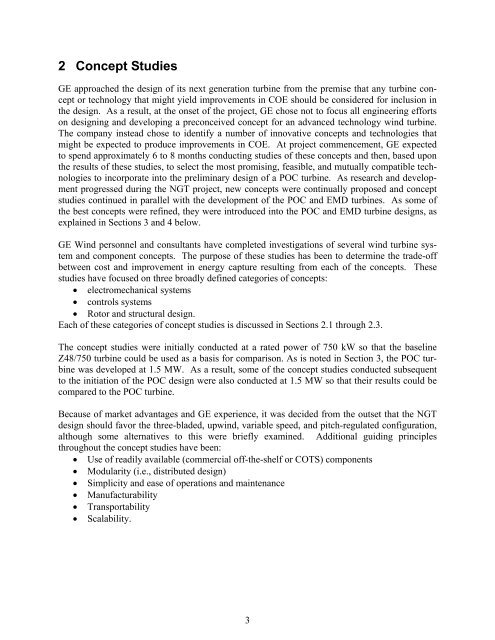Advanced Wind Turbine Program Next Generation Turbine ... - NREL
Advanced Wind Turbine Program Next Generation Turbine ... - NREL
Advanced Wind Turbine Program Next Generation Turbine ... - NREL
Create successful ePaper yourself
Turn your PDF publications into a flip-book with our unique Google optimized e-Paper software.
2 Concept Studies<br />
GE approached the design of its next generation turbine from the premise that any turbine concept<br />
or technology that might yield improvements in COE should be considered for inclusion in<br />
the design. As a result, at the onset of the project, GE chose not to focus all engineering efforts<br />
on designing and developing a preconceived concept for an advanced technology wind turbine.<br />
The company instead chose to identify a number of innovative concepts and technologies that<br />
might be expected to produce improvements in COE. At project commencement, GE expected<br />
to spend approximately 6 to 8 months conducting studies of these concepts and then, based upon<br />
the results of these studies, to select the most promising, feasible, and mutually compatible technologies<br />
to incorporate into the preliminary design of a POC turbine. As research and development<br />
progressed during the NGT project, new concepts were continually proposed and concept<br />
studies continued in parallel with the development of the POC and EMD turbines. As some of<br />
the best concepts were refined, they were introduced into the POC and EMD turbine designs, as<br />
explained in Sections 3 and 4 below.<br />
GE <strong>Wind</strong> personnel and consultants have completed investigations of several wind turbine system<br />
and component concepts. The purpose of these studies has been to determine the trade-off<br />
between cost and improvement in energy capture resulting from each of the concepts. These<br />
studies have focused on three broadly defined categories of concepts:<br />
• electromechanical systems<br />
• controls systems<br />
• Rotor and structural design.<br />
Each of these categories of concept studies is discussed in Sections 2.1 through 2.3.<br />
The concept studies were initially conducted at a rated power of 750 kW so that the baseline<br />
Z48/750 turbine could be used as a basis for comparison. As is noted in Section 3, the POC turbine<br />
was developed at 1.5 MW. As a result, some of the concept studies conducted subsequent<br />
to the initiation of the POC design were also conducted at 1.5 MW so that their results could be<br />
compared to the POC turbine.<br />
Because of market advantages and GE experience, it was decided from the outset that the NGT<br />
design should favor the three-bladed, upwind, variable speed, and pitch-regulated configuration,<br />
although some alternatives to this were briefly examined. Additional guiding principles<br />
throughout the concept studies have been:<br />
• Use of readily available (commercial off-the-shelf or COTS) components<br />
• Modularity (i.e., distributed design)<br />
• Simplicity and ease of operations and maintenance<br />
• Manufacturability<br />
• Transportability<br />
• Scalability.<br />
3
















